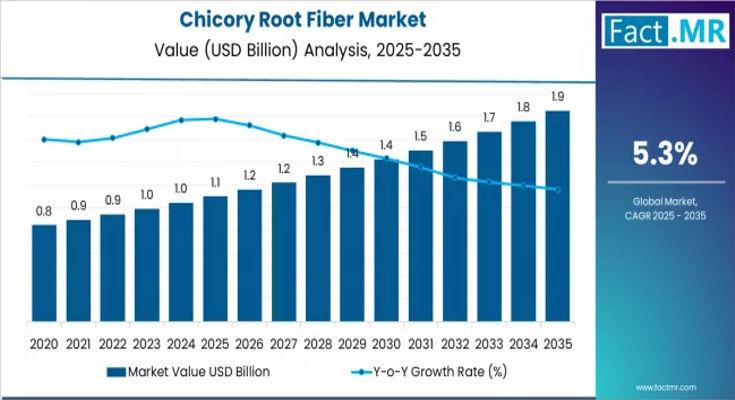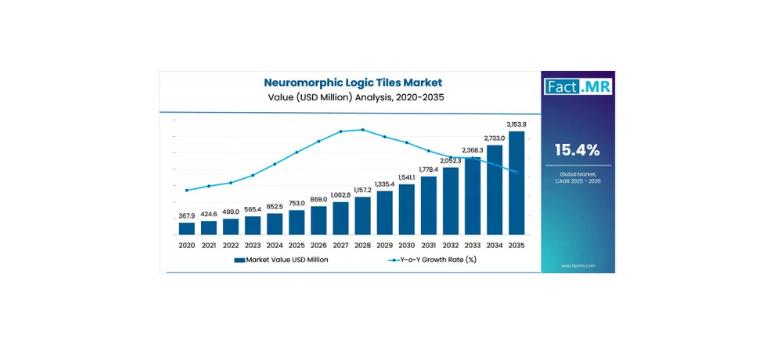Press release
Global Neuromorphic Logic Tiles Market to Surge to USD 3.15 Billion by 2035; Edge AI & Low-Power Computing Drive Uptake
The global market for neuromorphic logic tiles - hardware-software modules that mimic brain-like computing for energy-efficient AI workloads - is set to experience strong growth over the next decade. According to Fact.MR's latest study titled "Neuromorphic Logic Tiles Market Insights 2025-2035", the market is estimated at USD 252 million in 2025 and is projected to reach approximately USD 3,154 million (USD 3.15 billion) by 2035, representing a compound annual growth rate (CAGR) of 15.4%.Transformation from Traditional Processing to Brain-Inspired Architectures
Neuromorphic logic tiles emulate biological neural networks and enable event-driven, parallel, adaptive computation - offering major advantages in power consumption and latency when compared to classical von Neumann architectures. The Fact.MR report notes the module-hardware segment dominates early in the market, while software development tools and supporting hardware are gaining fast and will help scale the market over time.
These tiles are increasingly finding applications in edge AI devices, autonomous systems, industrial robotics, vision-and-sensor fusion, and advanced signal processing - sectors demanding fast real-time decisions with minimal energy draw. The report highlights that growth is being driven by rising global investments in AI, increased demand for edge intelligence in IoT devices, and partnerships between semiconductor, research and AI-platform firms.
To access the complete data tables and in-depth insights, request a Discount On The Report here: (sample link) https://www.factmr.com/connectus/sample?flag=S&rep_id=11274
Key Market Metrics at a Glance
Market Value (2025): USD 252 million
Forecast Value (2035): USD 3,154 million
Forecast CAGR (2025-2035): ~15.4%
Leading Segment in 2025: Module Hardware (~45.6% share)
Fastest-Growing Country Forecast: China (~15.9% CAGR)
Segment & Application Overview
By Component: The market divides into module hardware, supporting hardware, and software & development tools. Module hardware commands the largest share owing to significant demand for neuromorphic compute units. Software and tools are expected to grow strongly as the ecosystem matures.
By Technology: CMOS-based neuromorphic tiles currently lead because of compatibility with established manufacturing processes. Emerging technologies such as memristor/resistive-memory tiles and spintronic neuromorphic designs are positioned for future growth.
By Application: Key application areas include:
Image & vision processing
Signal & sensor fusion
Autonomous systems & robotics
Edge intelligence & AI/ML inference
These applications benefit from neuromorphic designs due to their need for real-time, energy-efficient processing of large sensory data.
By End-Use Industry: Critical industries adopting neuromorphic logic tiles include consumer electronics, automotive & mobility, industrial manufacturing, healthcare & life sciences, robotics, and cybersecurity.
Regional & Growth Dynamics
North America currently leads the market thanks to advanced R&D, presence of major chip players and early adoption of neuromorphic technology. Asia-Pacific is forecast to be the fastest growing region, driven by strong investments in AI hardware, semiconductor manufacturing expansion in China, Japan and South Korea, and rising demand for intelligent edge devices.
Europe maintains solid growth due to its strong electronics and automotive sectors. Other regions such as Latin America, Middle East & Africa are emerging, albeit from smaller bases, as digital transformation and edge-AI adoption increase.
Five Core Drivers of Growth
Energy-Efficient and High-Performance Computing Needs: Traditional architectures struggle with parallel processing and high power-draw; neuromorphic tiles offer an alternative optimized for AI tasks.
Edge AI Proliferation: Demand for intelligence at the edge (IoT, sensors, autonomous machines) is accelerating neuromorphic hardware uptake.
Research & Industry Collaboration: Partnerships between semiconductor manufacturers, academic labs and AI platform firms are accelerating commercialization and scale-up.
Automotive & Robotics Demand: Autonomous vehicles, drones, industrial robots and smart sensors require ultra-low-power hardware for on-device intelligence.
Manufacturing & Technology Readiness: The maturation of CMOS neuromorphic platforms and emerging alternatives (memristor/spintronic) supports broader deployment.
Challenges & Market Constraints
Despite strong prospects, the market faces hurdles: standardized architectures and frameworks for neuromorphic computing are still limited, hindering interoperability and large-scale adoption. Fabrication of neuromorphic hardware remains complex and costly, especially for emerging technologies. And a talent gap in combined neuroscience, semiconductor design and AI is slowing product development and market readiness.
Strategic Outlook: The Neuromorphic Era Begins
Over the next decade, neuromorphic logic tiles will move from niche research applications to mainstream deployment in edge AI, intelligent sensors and autonomous systems. Suppliers who combine hardware, software, algorithm ecosystems and domain-specific solutions will win. For end-users, adopting neuromorphic tiles promises lower power consumption, faster responses, and smarter devices.
Why This Report Matters
Fact.MR's neuromorphic logic tiles market study provides deep-dive insights into future architecture designs, component trends, application mapping and regional demand forecasts. For semiconductors, hardware designers, AI platform companies, robotics firms and investors, the report maps a clear route to opportunity in a rapidly evolving computing paradigm.
CTA for Paid PR
Purchase Full Report for Detailed
For access to full forecasts, regional breakouts, company share analysis, and emerging trend assessments, you can purchase the complete report here:Insightshttps://www.factmr.com/checkout/11274
Have a specific Requirements and Need Assistant on Report Pricing or Limited Budget please contact us - sales@factmr.com
To View Related Report:
Neuromorphic Hardware Market https://www.factmr.com/report/neuromorphic-hardware-market
Photonic Neuromorphics Market https://www.factmr.com/report/photonic-neuromorphics-market
Data Center Logical Security Market https://www.factmr.com/report/data-center-logical-security-market
Quantum Dot Logic Market https://www.factmr.com/report/quantum-dot-logic-market
- Contact Us -
11140 Rockville Pike, Suite 400, Rockville,
MD 20852, United States
Tel: +1 (628) 251-1583 | sales@factmr.com
About Fact.MR
Fact.MR is a global market research and consulting firm, trusted by Fortune 500 companies and emerging businesses for reliable insights and strategic intelligence. With a presence across the U.S., UK, India, and Dubai, we deliver data-driven research and tailored consulting solutions across 30+ industries and 1,000+ markets. Backed by deep expertise and advanced analytics, Fact.MR helps organizations uncover opportunities, reduce risks, and make informed decisions for sustainable growth.
This release was published on openPR.
Permanent link to this press release:
Copy
Please set a link in the press area of your homepage to this press release on openPR. openPR disclaims liability for any content contained in this release.
You can edit or delete your press release Global Neuromorphic Logic Tiles Market to Surge to USD 3.15 Billion by 2035; Edge AI & Low-Power Computing Drive Uptake here
News-ID: 4257717 • Views: …
More Releases from Fact.MR

European Chicory Root Fiber Market Outlook 2025-2035: Key Developments and Futur …
The global chicory root fiber market is projected to expand significantly over the next decade, driven by increasing demand for prebiotic dietary fibers, clean-label ingredients, and functional food formulations. The market is estimated to grow from USD 1.1 billion in 2025 to around USD 1.85 billion by 2035, reflecting a compound annual growth rate (CAGR) of 5.3%.
Key Market Highlights
2025 Market Value: USD 1,100.0 million
2035 Forecast Value: USD 1,850.0 million
Projected CAGR…

European Refillable Packaging Market Forecast 2025-2035: Trends and Growth Insig …
The global refillable packaging market is projected to expand significantly over the next decade, as businesses and consumers shift toward circular and sustainable packaging solutions. From an estimated USD 47.5 billion in 2025, the market is expected to reach approximately USD 75.0 billion by 2035, reflecting a compound annual growth rate (CAGR) of 4.7%.
Key Market Insights
2025 Market Value: USD 47.49 billion
2035 Forecast Value: USD 75.01 billion
Projected CAGR (2025-2035): 4.7%
Leading Packaging…

European Portable Power Station Market Outlook 2025-2035: Innovation, Growth, an …
The global portable power station market is set for explosive growth over the next decade, driven by rising demand for reliable, off-grid energy solutions in both residential and commercial settings. According to recent market research, the market is projected to increase from USD 4.2 billion in 2025 to USD 30.3 billion by 2035, representing a compound annual growth rate (CAGR) of 21.8%.
Key Market Highlights:
2025 Market Value: USD 4.2 billion
2035 Forecast…

European Liquid Soap Market Outlook (2025-2035): Key Developments & Future Scope
The European liquid soap market is poised for consistent, value-driven growth from 2025 to 2035, supported by sustained hygiene awareness, rising adoption of natural and dermatologically advanced formulations, and rapid expansion of refillable and sustainable packaging systems. As consumers shift from traditional bar soaps to premium liquid soap formats, manufacturers across Europe are entering a period of accelerated innovation and competitive differentiation.
Market Outlook (2025-2035)
The European liquid soap market is expected…
More Releases for Neuromorphic
Prominent Neuromorphic Computing Market Trend for 2025: Brainchip Revolutionizes …
"What Are the Projected Growth and Market Size Trends for the Neuromorphic Computing Market?
The neuromorphic computing market has expanded exponentially in recent years. It is expected to grow from $1.44 billion in 2024 to $1.81 billion in 2025, with a CAGR of 25.7%. Factors that contributed to its historical growth include significant advancements in AI, the growing use of cognitive computing applications, industry collaborations in neuromorphic computing, the demand for…
Major Market Shift in Neuromorphic Chips Industry: Launch Of Innovative Neuromor …
What Is the Forecasted Market Size and Growth Rate for the Neuromorphic Chips Market?
The neuromorphic chips market has witnessed rapid growth in recent years. It is forecasted to grow from $0.68 billion in 2024 to $0.78 billion in 2025, at a CAGR of 14.8%. The historical growth can be attributed to advancements in integrated circuit performance, increased adoption of speech and biometric recognition, progress in artificial intelligence (AI) and machine…
Neuromorphic Chip Market 2024 Research Report
Neuromorphic Chip Market
Neuromorphic computing is a branch of artificial intelligence (AI) that simulates the functionality of the human neuron. This report mainly studies Neuromorphic Chip market. A neuromorphic chip is an analog data processor inspired by the biological brain.
The global Neuromorphic Chip market was valued at US$ 16 million in 2023 and is anticipated to reach US$ 1228.4 million by 2030, witnessing a CAGR of 87.8% during the forecast…
Neuromorphic Computing Market: An Overview
Neuromorphic computing is a revolutionary approach that mimics the neural structure and functioning of the human brain. This technology aims to enhance computational efficiency and capabilities by creating hardware and software systems that can process information in a manner similar to biological systems. With its ability to handle vast amounts of data with lower power consumption, neuromorphic computing is gaining traction across various sectors, including artificial intelligence, robotics, and cognitive…
Neuromorphic Computing: Revolutionizing the Future of Technology
Neuromorphic computing is an advanced area of research and development that mimics the way the human brain operates. Unlike traditional computing systems that process information in a linear and sequential manner, neuromorphic systems are designed to emulate the brain's neural architecture. This approach allows for parallel processing, greater efficiency, and the potential to solve complex tasks more efficiently than conventional computers. Neuromorphic computing relies on specialized hardware and algorithms that…
Neuromorphic Computing Market- The Neuromorphic Computing Market Are Improving T …
Neuromorphic computing or neuromorphic engineering has been described as the use of large integration systems containing numerous analog circuits allowing the replication of neuro-biological behaviors existing in a human’s nervous system. The neuromorphic computing platform consists of two vital systems based on the custom hardware architecture. Such systems are designed to program neural microcircuits by applying brain-like thought process in cognitive computing and machine learning process. This procedure enables a…
